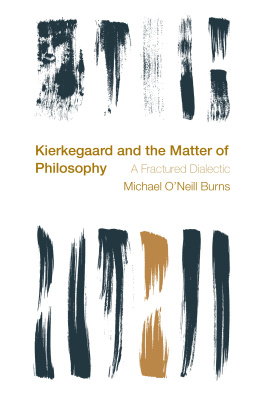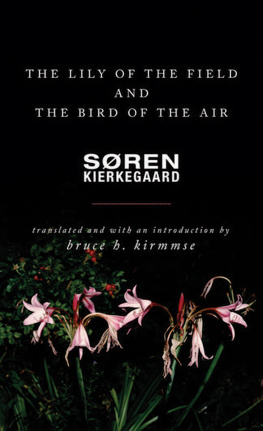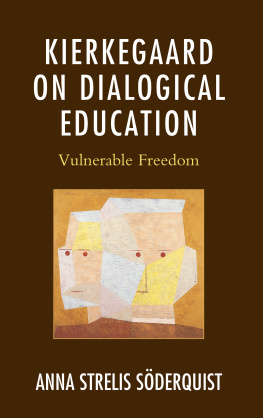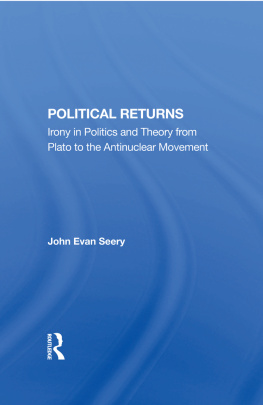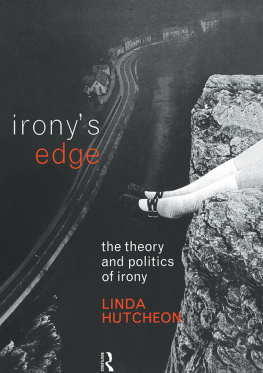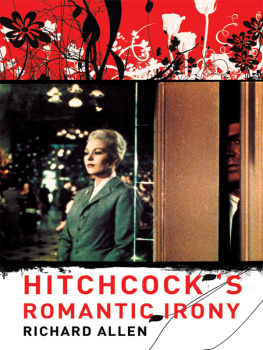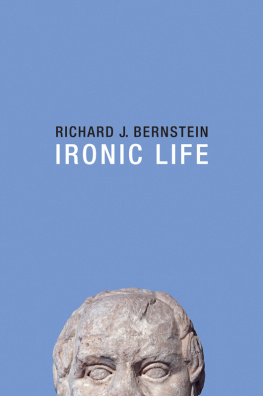THE CONCEPT OF IRONY
WITH CONTINUAL REFERENCE TO SOCRATES
KIERKEGAARDS WRITINGS, II

THE CONCEPT OF IRONY
WITH CONTINUAL REFERENCE TO SOCRATES
by Sren Kierkegaard
together with
NOTES OF SCHELLINGS BERLIN LECTURES
Edited and Translated
with Introduction and Notes by
Howard V. Hong and
Edna H. Hong
PRINCETON UNIVERSITY PRESS
PRINCETON, NEW JERSEY
Copyright 1989 by Howard V. Hong
Published by Princeton University Press, 41 William Street
Princeton, New Jersey 08540
In the United Kingdom: Princeton University Press, Chichester, West Sussex
All Rights Reserved
Library of Congress Cataloging-in-Publication Data
Kierkegaard, Sren, 1813-1855.
The concept of irony, with continual reference to Socrates.
(Kierkegaards writings; 2)
Translation of: Om begrebet ironi.
Bibliography: p.
Includes index.
1. Irony. 2. Socrates. 3. Schelling, Friedrich Wilhelm Joseph von, 1775
1854. I. Hong, Howard Vincent, 1912- . II. Hong, Edna Hatlestad,
1913-. III. Title. IV. Series: Kierkegaard, Sren, 1813-1855. Works. English. 1978; 2.
B4373.042E5 1989 190 89-3642
ISBN 0-691-07354-6 ISBN 0-691-02072-8 (pbk.)
Second printing, with corrections, and first paperback printing, 1992
Preparation of this volume has been made possible in part by a grant
from the Division of Research Programs of the National Endowment
for the Humanities, an independent federal agency
Princeton University Press books are printed on acid-free paper,
and meet the guidelines for permanence and durability of the
Committee on Production Guidelines for Book Longevity
of the Council on Library Resources
Designed by Frank Mahood
http://pub.princeton.edu
Printed in the United States of America
11 13 15 16 14 12
ISBN-13: 978-0-691-02072-3 (pbk.)
CONTENTS
The Concept of Irony,
with Continual Reference to Socrates
Part One
THE POSITION OF SOCRATES
VIEWED AS IRONY
APPENDIX
Hegels View of Socrates
Part Two
THE CONCEPT OF IRONY
HISTORICAL INTRODUCTION
On October 30, 1830, Sren Aabye Kierkegaard entered the University of Copenhagen. On September 29, 1841, he publicly defended his dissertation, The Concept of Irony, with Continual Reference to Socrates. For about eight of those eleven years, he appeared to be a typical perennial student. In the last three years, however, he not only completed intensive preparation for the climactic degree examination but wrote the 350-page dissertation and a considerable portion of Part II of Either/Or. In the midst of this concentrated work, he became engaged to Regine Olsen (September 10, 1840) and terminated the engagement within a fortnight after the dissertation defense.
Although the student years stretched out inordinately, Kierkegaard was not idle. He attended lectures and read extensively and intensively, but his mind was more preoccupied with his own creative thoughts than with formal study and completion of work for a degree. Four themes were of continuing interest: the ideas symbolized by Don Juan, Faust, the Master Thief, and the Wandering Jew.
Other journal entries and reading notes (on Jean Paul, Hamann, Wieland, Erdmann, Baur, and Grulich) from 1836 onward touch on Socrates, satire, humor, and irony,
No extant journal entries touch specifically on the decision to write on irony, but two important entries on Kierkegaards favorite teacher, philosophy professor Poul Martin Mller, point to a decision to write a substantial work. I recall the words of the dying Poul Mller, which he often said to me while he lived and which, if I remember correctly, he enjoined Sibbern
of filial piety to Sding, his fathers birthplace, July 19-August 6, 1840.
Having made the decision to prepare for the examination, Kierkegaard wrote with some pathos in his journal:
And you, too, my lucida intervalla [bright intervals], I must bid farewell, and you, my thoughts, imprisoned in my head, I can no longer let you go strolling in the cool of the evening, but do not be discouraged, learn to know one another better, associate with one another, and I will no doubt be able to slip off occasionally and peek in on youAu revoir!
S. K.
formerly Dr. Exstaticus
Another entry from the same time also reflects Kierkegaards deliberate shift to the arduous task of completing his studies: For a period of a year, a mile in time, I will plunge underground like the river Guadalquibirbut I am sure to come up again! What he came up to again after the examination and the Sding pilgrimage was assiduous application to his work on the dissertation on irony.
In the absence of a dated manuscript of The Concept of Irony at any stage of writing and in the absence of dates in the few scattered notes, it is not possible to be precise about the time of the writing of Irony. Quite likely, however, a fair portion of the first part was written in 1838-1839 following discussions with Poul Martin Mller and before the clear decision to prepare for the degree examination. The rather complicated style of the first part is reminiscent of the style of From the Papers of One Still Living (1838). It is unlikely that the entire work could have been written in the eleven months between the Jutland pilgrimage and submission of the dissertation on June 3, 1841, a period that also coincides almost exactly with the engagement period with its attendant claims upon Kierkegaards time and attention. In addition, Kierkegaard was
On June 2, 1841, Kierkegaard sent a petition to the king requesting permission to submit his dissertation in Danish rather than in Latin. In the petition, he points out that Martin Hammerich and Adolph Peter Adler had been permitted the use of Danish in their dissertations submitted in 1836 and 1840. No mention is made of the permission granted in 1840 to Hans Lassen Martensen, whose name was omitted probably because he would participate in the faculty judgment of Kierkegaards dissertation and because Martensen had been granted an honorary doctors degree by Kiel University and therefore did not defend his dissertation for a Danish degree. In his petition, Kierkegaard stated that the discussion of irony in the modern period made Latin inappropriate. He pointed out in addition that he had taught Latin and that the public defense would be in Latin.
On September 16, 1841, copies of the dissertation were ready at the print shop, and on September 29 Kierkegaard defended it in a public colloquium for seven and one-half hours, from ten to two oclock and four to seven-thirty. The official opponents were philosophy professor Frederik Christian Sibbern and Greek professor Peter Oluf Brnsted. The seven speakers from the audience included Kierkegaards brother Dr. Peter Christian Kierkegaard, the official advocate, and Dr. Andreas Frederik Beck, who later wrote a review of Irony. Kierkegaards public defense was his first and last participation in the official academic life of the University of Copenhagen.
Sibbern, as dean of the philosophical faculty, was the first reader and approved the dissertation, although he advised a pruning of the style, a change of title to make Socrates even more central, and the addition of Latin theses. The other faculty readers agreed essentially with Sibbern. Brnsted, however, added that it is the facultys business only to render acknowledgment of
Next page

